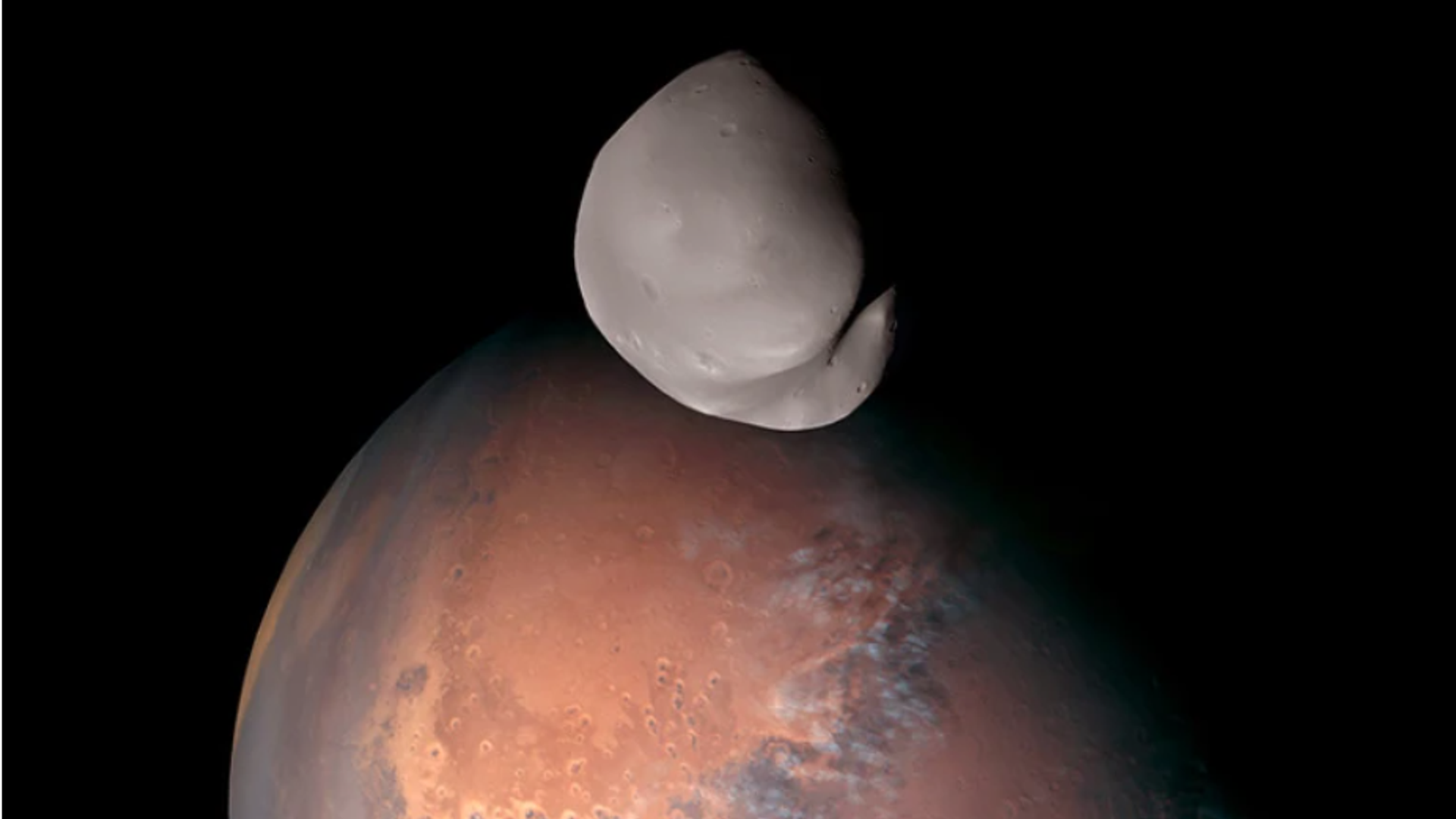https://sputnikglobe.com/20230426/video-probe-snaps-first-close-up-image-of-deimos--makes-shocking-find-1109838701.html
Video: Probe Snaps First Close-Up Image of Deimos & Makes Shocking Find
Video: Probe Snaps First Close-Up Image of Deimos & Makes Shocking Find
Sputnik International
A Mars satellite has shown its cratered face in an unprecedented photo. Deimos, one of the smaller moons of Mars, was photographed by the camera of the Martian mission Al Amal from a distance of only 100 km.
2023-04-26T04:18+0000
2023-04-26T04:18+0000
2023-04-26T08:48+0000
beyond politics
science & tech
mars
satellite
deimos
phobos
https://cdn1.img.sputnikglobe.com/img/07e7/04/1a/1109838544_0:87:926:608_1920x0_80_0_0_281473681a624762245baff331c4d846.png
Newly surfaced images of the Martian moon Deimos made quite the findings after determining that the moon originates from Mars itself, another step forward in resolving the long-term dispute over the nature of its formation.The Al Amal (Hope) probe of the UAE's Martian mission obtained an incredible image of Deimos, the smallest and most distant moon of Mars. The apparatus was able to fly around the satellite and approach it at a distance of 100 kilometers.In the shot, Mars is half in shadow and visible in the background. Deimos is mostly gray, resembling a potato, with a few clearly visible craters.Astronomers decided to take full advantage of this convergence, using all instruments available to them - ultraviolet and infrared spectrometers along with an imaging device. The opportunity allowed officials to capture incredible details of the moon's properties, including information about its composition and morphology.The origin of Deimos (and the other small Martian moon Phobos) has been a mystery since their discovery in 1877. Numerous spacecraft have photographed Deimos but always from a distance of more than 100 kilometers. Thus, it was difficult to determine the composition of the moon.The space probe was launched on a Japanese rocket in July 2020 and arrived at Mars in February 2021. Its main goal is to study seasonal variations in the planet's atmosphere and weather conditions.Data from recent images showed that the prevailing theory - until recently - that Deimos was an asteroid slowed down by Mars' orbit was incorrect. Scientists now believe Deimos was once part of Mars, but at some point, for some unknown reason, it broke away.
mars
deimos
phobos
Sputnik International
feedback@sputniknews.com
+74956456601
MIA „Rossiya Segodnya“
2023
News
en_EN
Sputnik International
feedback@sputniknews.com
+74956456601
MIA „Rossiya Segodnya“
Sputnik International
feedback@sputniknews.com
+74956456601
MIA „Rossiya Segodnya“
mars, deimos, uae probe al amal, mars probe hope, pictures od deimos 2023
mars, deimos, uae probe al amal, mars probe hope, pictures od deimos 2023
Video: Probe Snaps First Close-Up Image of Deimos & Makes Shocking Find
04:18 GMT 26.04.2023 (Updated: 08:48 GMT 26.04.2023) A Mars satellite has shown its cratered face in an unprecedented photo. Deimos, one of the smaller Martian moons, was photographed by the UAE's Amal spacecraft from a distance of only 100 kilometers, marking a first for observations of the satellite.
Newly surfaced images of the Martian moon Deimos made quite the findings after determining that the moon originates from Mars itself, another step forward in resolving the long-term dispute over the nature of its formation.
The Al Amal (Hope) probe of the UAE's Martian mission obtained an incredible image of Deimos, the smallest and most distant moon of Mars. The apparatus was able to fly around the satellite and approach it at a distance of 100 kilometers.
In the shot, Mars is half in shadow and visible in the background. Deimos is mostly gray, resembling a potato, with a few clearly visible craters.
Astronomers decided to take full advantage of this convergence, using all instruments available to them - ultraviolet and infrared spectrometers along with an imaging device. The opportunity allowed officials to capture incredible details of the moon's properties, including information about its composition and morphology.
"These images and observations represent a significant step forward in our knowledge of Deimos, its atmosphere, composition, origins, and what this means for our understanding of Mars more broadly," the UAE Space Agency said in a statement.
The origin of Deimos (and the other small Martian moon Phobos) has been a mystery since their discovery in 1877. Numerous spacecraft have photographed Deimos but always from a distance of more than 100 kilometers. Thus, it was difficult to determine the composition of the moon.
The space probe was launched on a Japanese rocket in July 2020 and arrived at Mars in February 2021. Its main goal is to study seasonal variations in the planet's atmosphere and weather conditions.
Data from recent images showed that the prevailing theory - until recently - that Deimos was an asteroid slowed down by Mars' orbit was incorrect. Scientists now believe Deimos was once part of Mars, but at some point, for some unknown reason, it broke away.


